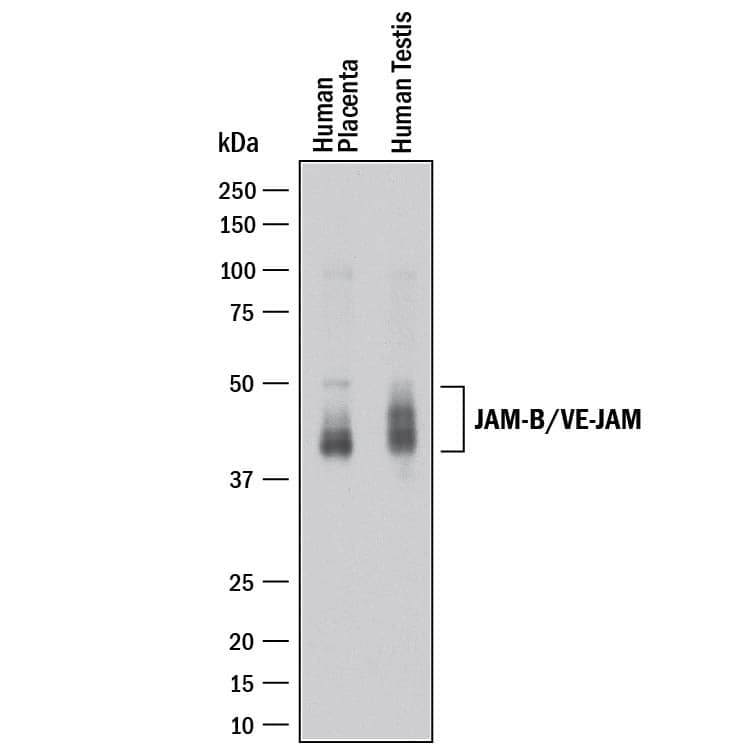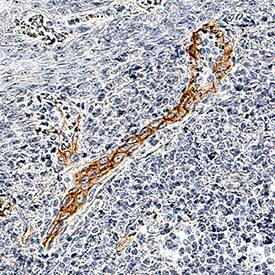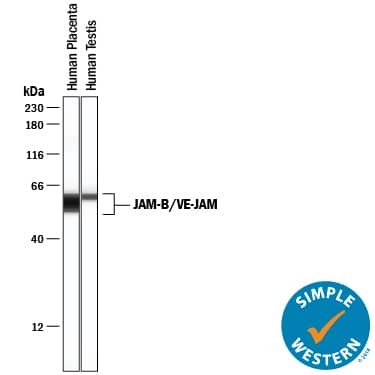Human/Mouse JAM-B/VE-JAM Antibody
R&D Systems, part of Bio-Techne | Catalog # AF1074


Key Product Details
Species Reactivity
Validated:
Cited:
Applications
Validated:
Cited:
Label
Antibody Source
Product Specifications
Immunogen
Phe29-Asn236
Accession # P57087
Specificity
Clonality
Host
Isotype
Endotoxin Level
Scientific Data Images for Human/Mouse JAM-B/VE-JAM Antibody
Detection of Human JAM‑B/VE‑JAM by Western Blot.
Western blot shows lysates of human placenta tissue and human testis tissue. PVDF membrane was probed with 1 µg/mL of Goat Anti-Human/Mouse JAM-B/VE-JAM Antigen Affinity-purified Polyclonal Antibody (Catalog # AF1074) followed by HRP-conjugated Anti-Goat IgG Secondary Antibody (Catalog # HAF017). Specific bands were detected for JAM-B/VE-JAM at approximately 43-50 kDa (as indicated). This experiment was conducted under reducing conditions and using Immunoblot Buffer Group 1.Detection of Mouse JAM-B/VE-JAM by Western Blot.
Western blot shows lysates of bEnd.3 mouse endothelioma cell line and SVEC4-10 mouse vascular endothelial cell line. PVDF membrane was probed with 2 µg/mL of Goat Anti-Human/Mouse JAM-B/VE-JAM Antigen Affinity-purified Polyclonal Antibody (Catalog # AF1074) followed by HRP-conjugated Anti-Goat IgG Secondary Antibody (Catalog # HAF017). Specific bands were detected for JAM-B/VE-JAM at approximately 40-48 kDa (as indicated). This experiment was conducted under reducing conditions and using Immunoblot Buffer Group 1.JAM-B/VE-JAM in Human Tonsil.
JAM-B/VE-JAM was detected in immersion fixed paraffin-embedded sections of human tonsil using Goat Anti-Human/Mouse JAM-B/VE-JAM Antigen Affinity-purified Polyclonal Antibody (Catalog # AF1074) at 3 µg/mL for 1 hour at room temperature followed by incubation with the Anti-Goat IgG VisUCyte™ HRP Polymer Antibody (Catalog # VC004). Tissue was stained using DAB (brown) and counterstained with hematoxylin (blue). Specific staining was localized to plasma membrane in endothelial cells. View our protocol for IHC Staining with VisUCyte HRP Polymer Detection Reagents.Applications for Human/Mouse JAM-B/VE-JAM Antibody
Immunohistochemistry
Sample: Immersion fixed paraffin-embedded sections of human tonsil
Simple Western
Sample: Human placenta tissue and human testis tissue
Western Blot
Sample: Human placenta tissue, human testis tissue, bEnd.3 mouse endothelioma cell line, and SVEC4‑10 mouse vascular endothelial cell line
Neutralization
Reviewed Applications
Read 1 review rated 4 using AF1074 in the following applications:
Formulation, Preparation, and Storage
Purification
Reconstitution
Formulation
Shipping
Stability & Storage
- 12 months from date of receipt, -20 to -70 °C as supplied.
- 1 month, 2 to 8 °C under sterile conditions after reconstitution.
- 6 months, -20 to -70 °C under sterile conditions after reconstitution.
Background: JAM-B/VE-JAM
The family of juctional adhesion molecules (JAM), comprising at least three members, are type I transmembrane receptors belonging to the immunoglobulin (Ig) superfamily (1, 2). These proteins are localized in the tight junctions between endothelial cells or epithelial cells. Some family members are also found on blood leukocytes and platelets. JAM-B, alternatively named vascular endothelial JAM (VE-JAM), is expressed prominently on high endothelial venules of lymphoid organs where it is localized to the intercellular boundaries of high endothelial cells. It is also expressed on the endothelium of a variety of non-lymphoid organs, especially the heart and placenta (3, 5). Human JAM-B cDNA predicts a 298 amino acid residue (aa) precursor protein with a putative 28 aa signal peptide, a 209 aa extracellular region containing two Ig domains, a 23 aa transmembrane domain and a 38 aa cytoplasmic domain containing a PDZ-binding motif and a PKC phosphorylation site. Human JAM-B shares approximately 79% aa sequence homology with its mouse homologue. It also shares approximately 35% aa sequence homology with human JAM-A or JAM-C. JAM-B exhibits homotypic interactions, as well as heterotypic interactions with JAM-C, but not JAM-A (4, 5, 7). It is also a ligand for the integrin alpha4 beta1. However, the JAM-B/ alpha4 beta1 interaction is facilitated only after prior adhesion of JAM-B to JAM-C (6). Through its heterotypic interactions with JAM-C, JAM-B is an adhesive ligand for T, NK, and dendritic cells, and may play a role in regulating leukocyte transmigration (5).
The nomenclature used for the JAM family proteins is confusing. VE-JAM has been referred in the literature variously as JAM-B or JAM-3. Until further clarification, R&D Systems has adopted the nomenclature where both mouse and human VE-JAM are referred to as JAM-B.
References
- Chavakis, T. et al. (2003) Thromb. Haemost. 89:13.
- Aurand-Lions, M. et al. (2001) Blood 98:3699.
- Palmeri, A. et al. (2000) J. Biol. Chem. 275:19139.
- Cunnigham, S. et al. (2000) J. Biol. Chem. 275:34750.
- Liang, T. et al. (2002) J. Immunol. 168:1618.
- Cunningham, A. et al. (2002) J Biol. Chem. 277:27589.
- Arrate, M. et al. (2001) J. Biol. Chem. 276:45826.
Long Name
Alternate Names
Gene Symbol
UniProt
Additional JAM-B/VE-JAM Products
Product Documents for Human/Mouse JAM-B/VE-JAM Antibody
Product Specific Notices for Human/Mouse JAM-B/VE-JAM Antibody
For research use only



